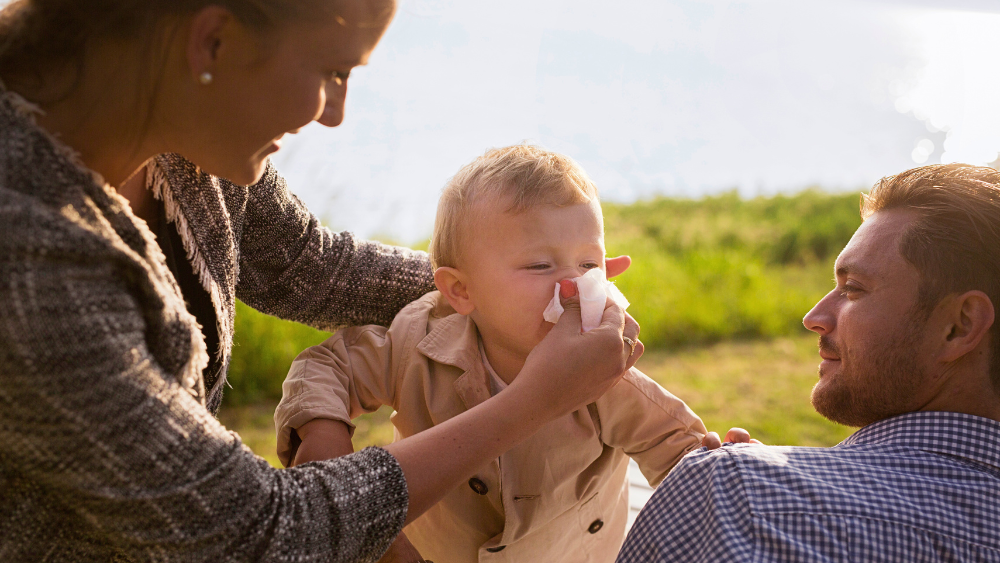The sun warms the air, flowers start to bloom, and for many, it signals the end of chilly days. But for some kids, it also means the start of sniffles, sneezes, and itchy eyes. Yes, it’s allergy season again.
Seasonal allergies, also called hay fever or allergic rhinitis, affect nearly 1 in 5 children across South Africa. If your little one seems to catch a “cold” every spring or autumn, allergies might be the real cause. Here’s what every parent should know about recognizing, managing, and treating seasonal allergies to help your child breathe easier and enjoy the outdoors.
Signs Your Child May Have Seasonal Allergies
Seasonal allergies happen when your child’s immune system reacts strongly to things like pollen from trees, grasses, or weeds, or even mold spores in the air. This reaction causes the body to release histamines, leading to common allergy symptoms such as:
- Runny or blocked nose
- Sneezing fits
- Itchy, watery, or red eyes
- Cough or sore throat
- Mucus dripping down the throat (postnasal drip)
- Feeling tired due to poor sleep caused by congestion
How to Tell Allergies Apart from a Cold
Allergy symptoms and common colds share some similarities, but there are key differences. Colds often bring thicker yellow or green mucus, body aches, and sometimes a fever. Allergies, however, usually cause clear watery mucus and don’t cause fever or body pain. Also, colds typically clear up within about 10 days, while allergies can last as long as your child is exposed to the allergen.
What Triggers Seasonal Allergies?
If your child’s symptoms appear every year during certain months, it’s probably due to seasonal allergens. Common triggers include:
- Tree pollen in spring
- Grass pollen in late spring and summer
- Weed pollen in late summer and autumn
- Mold spores, especially in damp weather
- Pollution and smoke, which can make symptoms worse
Dry and windy days usually bring higher pollen counts, while rainy days wash pollen away but encourage mold growth. Noticing when your child’s symptoms flare up can help pinpoint the cause.
Diagnosing Seasonal Allergies
If you think your child has allergies, their doctor may ask you to keep track of symptoms and when they occur. In some cases, they might recommend allergy testing to confirm which allergens cause problems.
Who needs testing?
Not all kids need tests. But if symptoms are severe, happen year-round, or don’t improve with treatment, an allergy test might be helpful. Tests include:
- Skin prick test: Tiny amounts of allergens are introduced to the skin to see if a reaction occurs.
- Blood test: Measures allergy-related antibodies in the blood, useful when skin testing isn’t possible.
Allergies often begin showing between ages 3 and 5, though it’s rare for children under 2 to have seasonal allergies.
Safe Treatments for Kids’ Seasonal Allergies
Not all allergy medicines are safe for young children, so always check with your child’s doctor before giving any medication.
- Antihistamines: These reduce sneezing, runny noses, and itchy eyes by blocking histamine chemicals.
- For babies 6 months and older: Cetirizine (Zyrtec), Desloratadine (Clarinex)
- For kids 2 years and older: Loratadine (Claritin), Fexofenadine (Allegra)
These newer antihistamines usually don’t cause drowsiness. - Nasal sprays:
- Saline sprays can safely rinse out pollen and allergens and are good for all ages.
- Steroid nasal sprays reduce swelling and congestion but should be used under doctor guidance. Generally:
- 2 years and up: Fluticasone furoate (Veramyst), Mometasone (Nasonex), Triamcinolone (Nasacort)
- 4 years and up: Fluticasone propionate (Flonase)
Avoid decongestant sprays for kids under 6 as they can cause rebound congestion.
Tips to Prevent Allergy Flare-Ups
While you can’t control the seasons, you can help protect your child from allergens:
- Check daily pollen counts and keep windows closed on high-pollen days.
- Have your child change clothes and shower after playing outside to wash off pollen.
- Use air purifiers indoors to reduce allergens.
- Encourage sunglasses and hats to block pollen from eyes and hair.
- Clean your home regularly by vacuuming and dusting to reduce indoor allergens.
When to See a Doctor
If your child’s allergies disrupt sleep, school, or play, or if they show signs of asthma (like wheezing or difficulty breathing), it’s time to visit a doctor. An allergist can help create a personalized treatment plan and may recommend allergy shots if needed.

